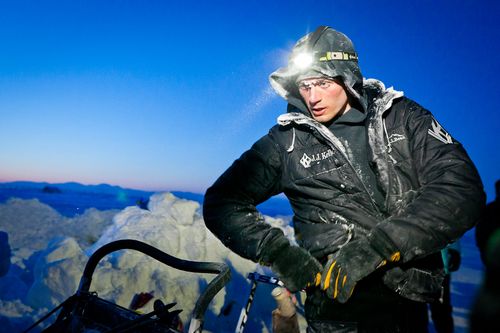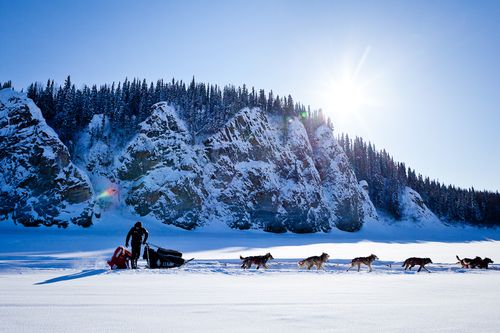
Dallas Seavey [all photos courtesy of Loren Holmes; ]
Last week, 25-year-old became the youngest musher ever to win the Iditarod. A third generation musher—his father and grandfather (one of the race’s founders) are past Iditarod champions—Seavey grew up dog sledding and completed his first race when he was five. When he crossed the finish line on March 13 in Nome, after nine days and 975 miles on the trail, he edged out , 41, by one hour, one of the narrowest margins in race history.
Guest blogger Elizabeth Sullivan��caught up with Seavey and Zirkle, while they were still in Nome, to find out how they got into the sport and how young mushers can, too.

Seavey & co on the go
Seavey and Zirkle (r) during a rare moment of rest mid-race
What’s your relationship like with your dogs?
AZ: The dogs are like people. They have pluses and minuses. Some of them are really smart: They know what they want to do and what I want them to do. Some aren’t that smart, but they want to please you, so they work to figure out what you want. Others are independent and want to tinkle on a bush. You can’t get frustrated with the dogs, they are like people: they are who they are and doing the best they can. I give them a chance to be themselves, and that is why they were so successful this year. They shined.
DS: There’s bond after thousands of miles of training and racing. Derby has been with me for the last five out of six Iditarod races, and I would not have gotten out of situations without Guinness’s strength and expertise.
Do you have any tips for aspiring young mushers?
DS: It’s a great sport that teaches responsibility and animal husbandry. I encourage a young person to get involved if they like dogs, but it’s not like a soccer ball that you can kick around for a week and then toss the ball in the closet when you get bored. Having a dog is a commitment to be respected. To get involved, be around the sport at least a winter to realize the time and responsibility it takes to do it properly. We have junior mushers and older people come and work in the kennel to learn. Our workdays are 12 to 14 hours long, doing vet care, preventative measures, mushing; it’s heavy work.
Do you mentor young mushers yourself?
AZ: I sponsor [a young musher named] Ruth Ann. She’s 11 years old, and I send her a little bit of money so she can do 20-mile races. There is also the Junior Iditarod, but I love the little races where you get the four- and five-year olds on a little one dog sled and they do quarter-mile track and hang on with huge smile on their faces. Our dog, Stormy is very patient with youngsters, so that’s important. We take the step nephews and grandbabies out, and holy cow they are a handful. They are the best part of it.
What if you want to be a musher, but don’t live in Alaska?
DS: There are camps available in some places [Minnesota, Michigan, and Wisconsin], and within Alaska there are 4H clubs. Most mushing communities want to help young people get into the sport and do this by having them help out as an apprentice. We had a father and son from New York come out for over a month, and now they have a few dogs. Most top mushers are willing to help and support others getting into the sport. I’d love to see the Iditarod grow and survive and invite more people to join us who will respect the sport and its athletes.
What’s the first thing you ate when you got off the trail?
AZ: Nome is known for its seafood, so my family checked the crab pots and brought back ten king crabs. They were so fresh we didn’t even need to eat them with butter. Just crab and bread.
DS: I was starving coming off the Iditarod. Thankfully, my wife knows me pretty well, and she had a giant double bacon cheeseburger waiting for me at the finish line that hit the spot.
If you could go anywhere in the world, where would it be and why?
DS: Home. That sounds real nice about now.
—Elizabeth Eilers Sullivan